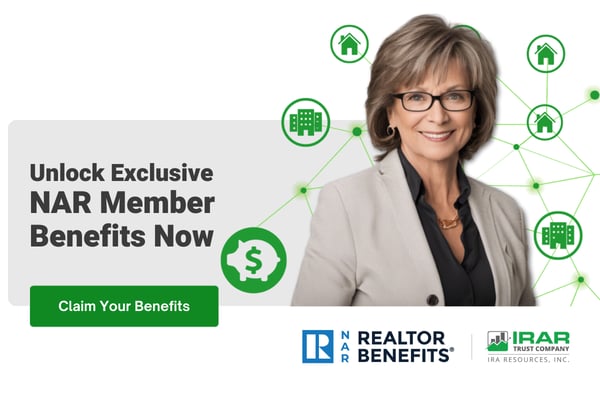How To Grow Your SDIRA Substantially Faster

Many of you have been humming along at your jobs, contributing to employer-sponsored retirement plans and happy with that. But not all plans are equal and not all employers match your contributions. Some plans are great: You contribute up to the max allowable to bulk up your retirement and create a better quality of life when you are ready to hang it up. Others may not have such a great retirement plan, but you don't know any better and you don't have an investment professional proposing other options.
I'm not here to advise you about the best retirement plans available or give any legal, tax or investment advice. You need to do what is best for you, with the proper research and the proper help from the appropriate professionals. What I want to share with you, though, is a true story about how real estate can supplement your retirement goals and how you can use your retirement money to invest in all kinds of real estate.
Specifically, I’ll be focusing on Self-Directed IRAs or SDIRAs. The typical person— say 95%+ of people— who have an IRA of some form have their money invested in the market. When I say market, I mean the stock market, in a specific fund, single or multiple stocks, or an index perhaps. Your employer may take care of these plans for you, or maybe an advisor helped you find an IRA plan. When you self-direct an IRA, you can basically direct your retirement money into whatever you would like to invest it in. Generally, people like to invest in things they are familiar with. So perhaps someone who doesn't like the stock market or its volatility may decide to pull their money out and go in a different direction with their retirement savings.
There are some exceptions to the rule regarding where you can self-direct your IRA. You cannot self-direct your IRA into collectibles such as cards or coins, nor can you invest it into life insurance policies. The only other thing not permitted is an S corp.
But because some people are familiar with real estate, for example, it may make more sense for them to focus their retirement finances in that direction. This type of familiarity makes an SDIRA in real estate a no brainer for them. Or perhaps they have no real estate in their retirement plan so they want to diversify and add some real estate to their general retirement planning.
Having a real estate SDIRA is what I want to focus on here. As mentioned above, you can go in many different directions with an SDIRA but I'm a real estate broker and I only have experience with helping clients find and close on real estate that they have purchased and currently hold within their SDIRA accounts. You may be asking yourself: Why do I need to buy a real estate investment with my retirement account instead of money in my regular savings accounts? The answer is you don't. You can purchase an investment property and pay cash, or get a non-occupied loan for the balance of the purchase price and the down payment. But in doing this you would need to have enough income to justify the debt-to-income ratio and have the appropriate amount of reserves in the bank to make six months of payments, for instance. Real estate investments like that are totally different, and typically use non-qualified money (non-retirement), etc. However, in California, due to the high price of real estate, it is becoming very difficult for the majority of people to afford a primary residence, let alone a separate investment property. Debt-to-income ratios are keeping the majority of Californians out of real estate investments because their incomes don't justify multiple mortgages.
Sharing an experience I had with one client may help explain the benefits of real estate investments in an SDIRA. I had a client who was earning less than 2% interest on his 403(b) plan at work. He was a nurse and had 20 years with his employer when he decided to switch employers. Somewhere along the way he learned about SDIRAs and how to use them to invest in real estate. He already had a regular rental property or two so he wasn't afraid of real estate investments. His first step was to roll over his retirement plan into an SDIRA. He hired a CPA, an attorney and a plan administrator to handle the paperwork and oversee the SDIRA. He also formed an LLC. An attorney helped him with these things. His startup fee for everything was around $2,000 or less for all these services, back in 2013.
He then identified a 4-bedroom 2-bathroom single-family home for sale in an area where he lived and was familiar with. We made an offer through his newly-formed LLC, got into contract and closed on the property for $177,000. Instead of finding a property around the $131,000 range which was the approximate value of his account when he rolled it over, he wanted something in a nicer area that he wouldn't have a hard time finding a renter for, so he had to borrow the difference. In this case, he was able to secure a non-recourse loan for his IRA, making sure the property could earn enough to pay the monthly mortgage, with at least 25% left over every month for repairs, vacancies and emergencies.
These are very unique loans with strict guidelines and low loan-to-value (LTV) requirements. He could have partnered with one or more people, even one or more retirement accounts, but he chose the loan option as the best option for him. These loans at the time were not based upon his income, assets or credit as they function more like a commercial loan. The lender only cares if the cash flow or rents are high enough so the borrower will not default on the loan payments, etc. This also means that if the property foreclosed, the buyer would have no adverse effects on his personal credit report.
Fast forward seven years to 2020: He made extra payments on his 10-year amortized loan. He was able to pay it off in seven years instead of ten. He paid the mortgage balance early using only an excess of rent payments received from the tenants. Since this is qualified money with tax deferred qualities, he could not commingle qualified money with non-qualified money without the IRS issuing a 10% penalty plus automatically generating a taxable event, if he was in violation of the IRA tax laws.
He liked this investment so much he decided to purchase another property the same way. Only this time, since he now owned a home free and clear, he would leverage that home, borrow against it with a cash-out refinance and put most of that refinance money as a down payment on his next home purchase.
He would get two loans to accomplish buying his second home within his SDIRA. One loan would be the cash-out refinance of the home now owned free and clear. Then he obtained a separate purchase money loan on the new property. His LTV would be right under 50% for both properties. Now he would control $550,000-$575,000 in real estate between two different homes within his SDIRA. So in seven years time, he was able to turn $131,000 of retirement funds into controlling almost $600,000 in assets. Now, he has two loans totaling less than $300,000 but his renters will pay that off in an estimated 10-12 years.
Instead of analyzing what he owns now or what this means for his retirement account when he retires (that could be a topic for a future post), let's consider his rate of return before he purchased the second property. We’ll compare his experience with real estate in his SDIRA to his previous employer-sponsored plan where he earned about 2%. Let's start with the $131,000 which he rolled over. Now, I am not a mathematician nor do I know a fancy formula to calculate compound interest. So I just used my handy dandy calculator and experimented with three different interest rates compounded over 7 years before I was able to determine an approximate interest rate for his SDIRA.
Now, when he was ready for the cash out refinance, Zillow estimated it was worth $310,000. When he had the home appraised for the cash out refinance loan, the value came in lower. Granted, the appraiser had no duty to appraise it for a contract price because this was a refinance only. Had there been a purchase contract I believe the value would have come in higher. The appraiser only gave it a value of $292,000. I am also confident that if he had me sell the home, we would have had multiple offers over $300,000 and perhaps even higher than Zillow suggested. Our market was really hot for homes of this size and price in this area. Also, he had a reserve balance in his IRA account of about $10,000. So taking the appraised value of $292,000 and adding $10,000, let’s say his account value was $302,000 combined. Or if we take the Zestimate value of $310,000 and add the $10,000 reserve, we would get $320,000. I'm sharing both of these values because a compounded interest rate of 13% over 7 years using the $131,000 original rolled over retirement account would yield about $308,000. And $308,000 is $3,000 away from being in the middle of $302,000 and $320,000.
So in this instance with my client, over the past seven years his SDIRA earned an interest rate that was more than SIX TIMES greater than the interest he would have earned had he not changed jobs and left his retirement account alone with the employer- sponsored plan. That is a staggering windfall for him! These returns are not guaranteed. Much of his returns are based upon property appreciation during those years and leveraging his retirement account with a non-recourse loan which allowed him to control more money within his retirement account. You can't borrow against your assets in the stock market unless you are buying options and you better really know what you are doing if you are playing the options game.
I'm not suggesting you can match these returns if you do the same thing. Don't misunderstand me here. In a depreciating real estate market, these numbers don't look even remotely as good. But in my client's instance, he is very happy with what he did. And I am very happy that I was able to play a small role in helping him have more financial security when he becomes more dependent on his retirement savings.
By: Jason Nenadov, Real Estate Broker
Equity Assets Real Estate
Clovis, California | 559-246-8991| jasonnenadov@gmail.com
Disclaimer: IRA Resources does not affiliate itself or make any recommendations to any person or entity associated with investments of any type (including financial representatives, investment promoters or companies, or employees, agents or representatives associated with these firms). IRA Resources is not responsible for and is not bound by any statements, representations, warranties or agreements made by any such person or entity and does not provide any recommendation on the quality, profitability, or reputability of any investment, individual or company.










Comments (0)